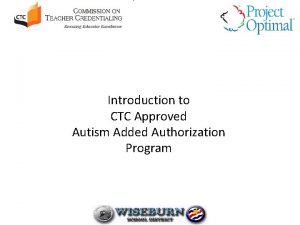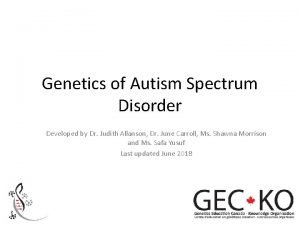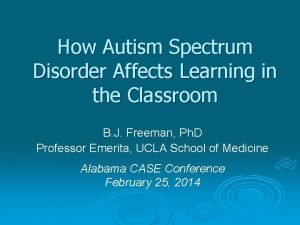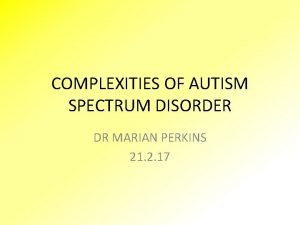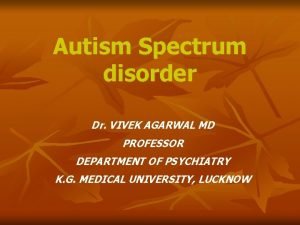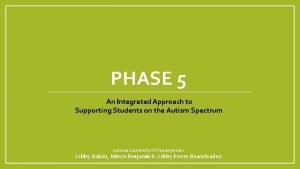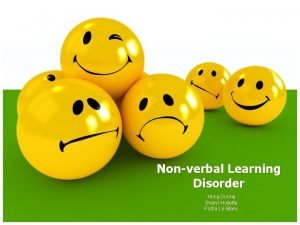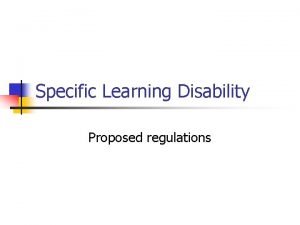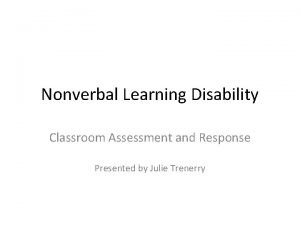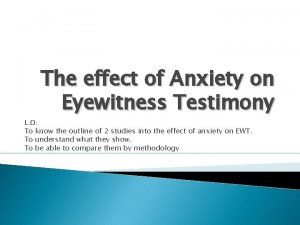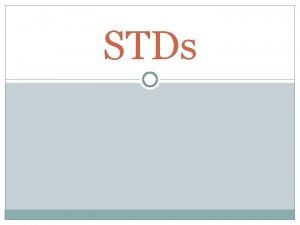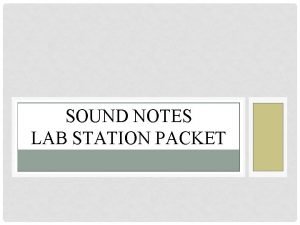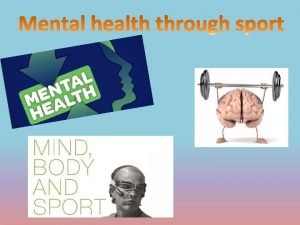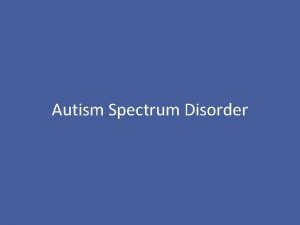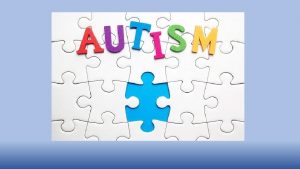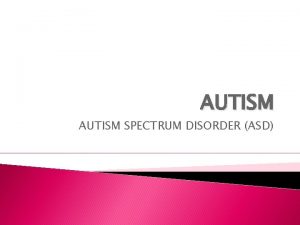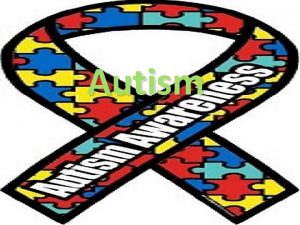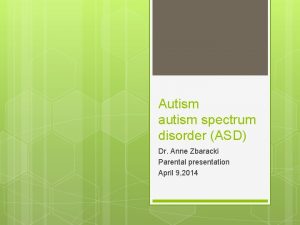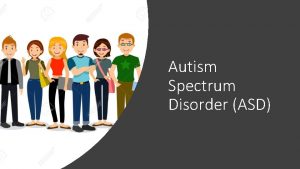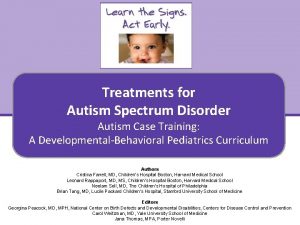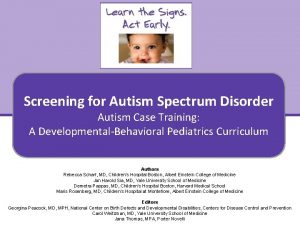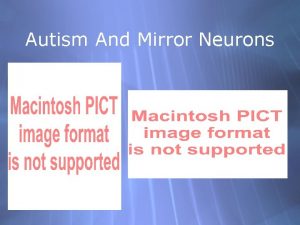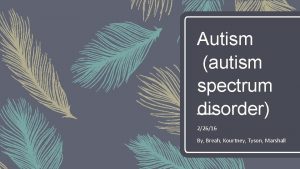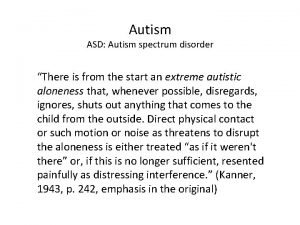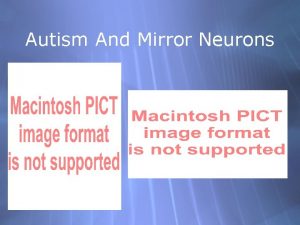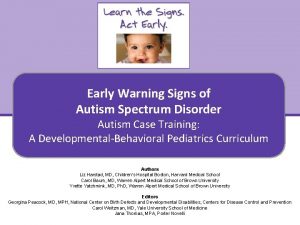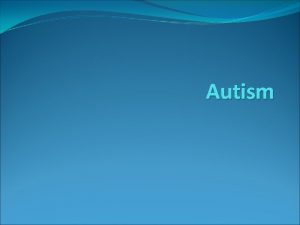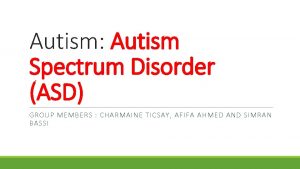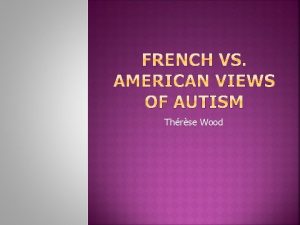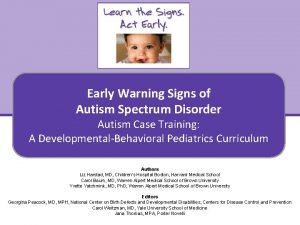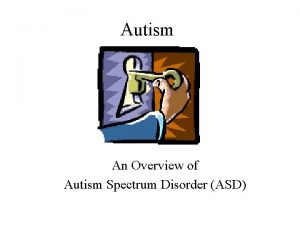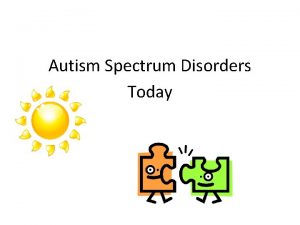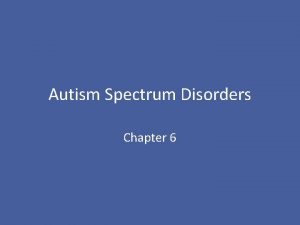How Autism Spectrum Disorder Affects Learning in the









































































- Slides: 73

How Autism Spectrum Disorder Affects Learning in the Classroom B. J. Freeman, Ph. D Professor Emerita, UCLA School of Medicine Alabama CASE Conference February 25, 2014

Autism Spectrum Disorders are best viewed as social-communication learning disabilities. ASDs represent a wide spectrum of abilities and disabilities.

All children with ASDs require intense multi-disciplinary evaluations and intensive early intervention (as soon as diagnosed) that focuses on teaching social communication skills in the natural environment.

Research has shown that even very mild social communication issues in younger children can result in significant behavior issues as they age. Current consensus is that the best approach to intervention for the core symptoms of ASDs includes a program of coordinated, intensive educational and behavioral intervention.

The most tested intervention is applied behavior analysis (ABA) which has been shown to significantly improve the core symptoms in almost all children. Complete recovery is rare, but the number of children showing recovery has been increasing over the past few years.

Recent research has demonstrated that early intervention actually changes brain function.

Diagnostic Criteria For 299. 0 ASD A. Persistent deficits in social communication and social interaction across multiple contexts, as manifested by the following, currently or by history:

1. Deficits in social-emotional reciprocity, ranging, for example, from abnormal social approach and failure of normal back-andforth conversation; to reduced sharing of interests, emotions or affect; to failure to initiate or respond to social interactions.

2. Deficits in nonverbal communicative behaviors used for social interaction ranging, for example, from poorly integrated verbal and nonverbal communication, to abnormalities in eye contact and body language or deficits in understanding and use of gestures, to a total lack of facial expressions and nonverbal communication.

3. Deficits in developing, maintaining and understanding relationships ranging, for example, from difficulties adjusting behavior to suit different social contexts, to difficulties in sharing imaginative play and in making friends, to absence of interest in peers.

Severity Level is specified based on the person’s specific communication impairments.

Severity Level 1: Requires support for deficits in social communication that cause noticeable impairments without supports in place; difficulty initiating social interactions, and clear examples of atypical or unsuccessful response to social overtures of others. (For example, a person who is able to speak in full sentences and engages in communication but whose to- and-fro conversation with others fails, and whose attempts to make friends are odd and typically unsuccessful. )

Severity Level 2: Requires substantial support for marked deficits in verbal and nonverbal social communication skills; social impairments apparent even with supports in place; limited initiation of social interactions; and reduced or abnormal responses to social overtures from others. (For example, a person who speaks simple sentences, whose interaction is limited to narrow special interests, and who has markedly odd nonverbal communication. )

Severity Level 3: Requires very substantial support for severe deficits in verbal and nonverbal social communication skills that cause severe impairments in functioning; very limited initiation of social interactions and minimal response to social overtures from others. (For example, a person with few words of intelligible speech who rarely initiates interaction and, when he or she does, makes unusual approaches to meet needs only and responds to only very direct social approaches. )

B. Restricted, repetitive patterns of behavior, interests or activities as manifested by at least two of the following, currently or by history:

1. Stereotyped or repetitive motor movements, use of objects, or speech, (e. g. , simple motor stereotypies, lining up toys, or flipping objects, echolalia, idiosyncratic phrases).

2. Insistence on sameness, inflexible adherence to routines, or ritualized patterns of verbal or nonverbal behavior (e. g. , extreme distress at small changes, difficulty with transitions, rigid thinking patterns, greeting rituals, need to take same route or eat same food every day).

3. Highly restricted, fixated interests that are abnormal in intensity or focus (e. g. , strong attachment to or preoccupation with unusual objects, excessively circumscribed or perseverative interests).

4. Hyper- or hyporeactivity to sensory input or unusual interest in sensory aspects of the environment (e. g. , apparent indifference to pain/temperature, adverse response to specific sounds or textures, excessive smelling or touching of objects, visual fascination with lights or movement).

Severity Level is specified based on the person’s restricted, repetitive patterns of behavior.

Severity Level 1: Requires support for inflexibility of behavior that causes significant interference with functioning in one or more contexts; difficulty switching between activities; problems of organization and planning that hamper independence.

Severity Level 2: Requires substantial support for inflexibility of behavior, difficulty coping with change, or other restricted/repetitive behaviors that appear frequently enough to be obvious to the casual observer and interfere with functioning in a variety of contexts; distress and/or difficulty changing focus or action.

Severity Level 3: Requires very substantial support for inflexibility of behavior, extreme difficulty coping with change, or other restricted/repetitive behaviors that markedly interfere with functioning in all spheres; great distress/difficulty changing focus or action.

C. Symptoms must be present in the early developmental period (but may not become fully manifest until social demands exceed limited capacities, or may be masked by learned strategies in later life).

D. Symptoms cause clinically significant impairment in social, occupational of other important areas of current functioning.

E. These disturbances are not better explained by intellectual disability (intellectual developmental disorder) or global developmental delay. Intellectual disability and autism spectrum disorder frequently co-occur; to make comorbid diagnoses of autism spectrum disorder and intellectual disability, social communication should be below that expected for general developmental level.

Characteristics of Curriculum How to Select Skills/What to Teach Skills should be meaningful to the student, functional, age appropriate and lead to independent functioning in the natural environment.

What Skills Should Be Selected? • Multiple environments: Skill will enhance student’s functioning in increased number and range of environments. • Functionality: If student does not perform the skill, someone else will have to do it for them.

• Chronological Age Appropriateness: Skill is culturally sanctioned within student’s age group. • Practice: Student will have opportunities to perform skill under non-instructional conditions, once acquired.

• Required in Adulthood: Skill is required, needed, respected or allowed expression in post school years. • Student Preference: Student will enjoy being able to perform the task. • Parent Preference: Parent would like student to learn the skill.

• Physical Enhancement: Skill will enhance the student’s physical well being. • Social Contact Enhancement: Skill will increase student’s chances for positive social interactions, particularly with nondisabled peers.

• Acquisition Probability: Student should be able to acquire skill in a reasonable period of time if adequate resources are devoted to its instruction. • Status Enhancement: Skill will enhance student’s status in the eyes of many non-disabled people.

Six kinds of intervention should have priority: 1. Functional, spontaneous communication should be the primary focus of early education. 2. Social instruction should be delivered throughout the day in various settings, using specific activities and interventions planned to meet age appropriate, individualized social goals.

3. Teaching of leisure skills should focus on activities with peers, with additional instruction in appropriate use of toys, games and other materials.

4. Other instruction aimed at goals for cognitive development should be carried out in the context in which skills are expected to be used, with generalization and maintenance in natural contexts as important as acquisition of new skills.

Because new skills have to be learned before they can be generalized, documentation of rates of acquisition is an important first step. Methods of introduction on new skills may differ from teaching strategies to support generalization and maintenance.

5. Intervention strategies that address problem behaviors should incorporate information about the contexts in which behaviors occur, positive proactive approaches, and a range of techniques that have empirical support (e. g. , functional behavior assessment, functional communication training, reinforcement of alternative behaviors).

6. Functional academic skills should be taught when appropriate to the child.

Taking into account the needs and strengths of an individual child and his/her family, the child’s schedule and educational environment in and out of the classroom should be adapted as needed in order to implement the IEP.

Educational services should include a minimum of 25 hours a week, with no more than a 2 -week break, where the child is engaged in systematically planned, developmentally appropriate activities aimed toward identified objectives.

Where activities take place and content of activities should be determined on an individual basis, depending on characteristics of the activity, the child and family.

Individual Instruction • The child must receive sufficient individualized attention on a daily basis so that individual objectives can be effectively implemented. • Individualized attention should include individual therapies, developmentally appropriate small group instruction, and direct 1: 1 contact with teaching staff.

• Need to teach readiness skills for learning before curriculum. • Ongoing assessment of the child’s progress in meeting objectives should be used to further refine the IEP.

• Lack of objectively documentable progress over 3 -month period should be taken to indicate a need to increase intensity by lowering student/teacher ratios, increasing programming time, reformulating curricula, or providing additional training and consultation.

• To the extent that it leads to specified educational goals (e. g. , peer interaction skills, independent participation in regular education), children should receive specialized instruction in settings in which ongoing interactions occur with typically developing children.

Characteristics of Teacher Interaction Strategies: • working knowledge of ASD characteristics • develop sense of trust between teacher and student with ASD • accept student’s cognitive and social abilities, and learning potential • accept student for who he or she is • training in ABA

Characteristics of Learning Environment Individualized Supports & Services: • Should be based on applied behavior analysis (ABA).

• Incorporation of child’s preferences & special interests into instructional program. • Focus on child’s strengths & weaknesses to determine the most appropriate density and level of instruction to meet child’s individual goals.

Systematic Instruction: • Targeting meaningful skills to be taught. • Planning when & how to provide instruction based on unique characteristics of student. • Determining data collection method to measure student’s progress & instructional effectiveness.

Comprehensible, Structured Learning Environment: Organize instructional setting • Provide schedule of activities • Carefully plan & provide choice-making opportunities • Provide behavioral support •

Define specific areas of classroom, school settings • Provide temporal relations • Facilitate transitions, flexibility, change •

Goals of the Classroom: • Increase accessibility to learning by decreasing disruptive/aggressive behaviors. • Maximize learning (pre-academic, self-care, motor skills, receptive/expressive learning, etc. ) • Maximize communication • Readiness for learning

Signs of a Good Class: • • • extensive reinforcement systematic intervention plans continuous teaching/no down time comprehensive programming natural teaching

Instructions designed for Educators: • Communicating to the student • Encouraging communication with the student • Social supports – includes specific teaching, rehearsal, practice & modeling of social skills in natural settings.

• • • Environment & Routine Presentation of material Assessment & assignments Homework Self-management of behavior

Functional Behavior Assessment • Dynamic process that addresses behavior on individual basis. • Is a work in progress – should not be fixed. • Key to success

10 steps toward supporting appropriate behavior in the classroom: 1. Understand characteristics of ASDs that may influence student’s ability to learn and function in school environment. 2. Acknowledge that behavior serves a function, is related to a context, and is a form of communication.

3. Use FBA as first step in designing behavior support plan: • identify, describe behavior • describe setting, demand, antecedent • collect baseline data, work samples

• complete functional analysis, develop hypothesis • develop & implement positive behavior support plan • collect data, monitor effectiveness • revise as needed

4. Think PREVENTION. 5. Use antecedent and setting event strategies. 6. Make teaching alternative skills an integral part of program. 7. Effective behavioral change may require everyone involved to change their behavior as well.

8. Design long-term prevention plan. 9. Discuss how student fits into school-wide discipline practices & procedures. 10. Collaborate, hold regular team meetings.

ABA Strategies • Should not focus on excessive behaviors, but lack of new skills • Most studied, most scientific support • Curriculum consisting of simple & complex target behaviors involving hundreds of programs developed through years of research.

• Child-specific curriculum adaptations • Task analysis • Repeated practice through discrete trials • Masses expanded, dispersed formats • Clear, discriminable instructions

Common Behavior Strategies Proactive procedures: • identify function of disruptive behavior • select replacement behavior • break skill into discrete parts • teach discrete skill until mastery • concentrated & systematic teaching • provide assistance as necessary • make learning fun & as natural as possible • provide reinforcer for appropriate behavior

Reactive procedures: • create behavioral momentum • provide reinforcer for absence of disruptive behavior • disruptive behaviors result in least amount of attention necessary & loss of opportunity for reinforcement • shape de-escalation • remain calm

Reinforcement guidelines: • Cannot assume! • Reinforcers should be reinforcing. • Reinforcement should be contingent & may have to be taught. • Use a variety of reinforcers. • Pair social with tangible reinforcers. • Continuously develop reinforcers.

• Initially, reinforcement should occur immediately. • Thin reinforcement schedule as soon as possible. • Label behavior being reinforced. • Don’t use bribery. • Utilize differential reinforcement.

Goal is for the natural environment to take over the reinforcement and the person learns to control his/her own behavior.

Common Misunderstood Behaviors Compliance: • • • Is the instruction necessary? Does the child understand instruction? Will you/Can you follow through? Don’t issue multiple instructions. Provide choices when possible. Phrase with expectation of compliance.

• • • Create behavioral momentum. Catch the child listening. Give in early. Provide meaningful consequences. Utilize errorless compliance training program. • If non-compliance occurs, provide least amount of attention.

Stress management: • Develop calming place • • • Create calming object Teach concept of calm Identify stressors Arrange stressors into a hierarchy Teach relaxation skills (holding object, guided imagery)

• • • Expose to mild stressor Cue relaxation Reinforce calm Fade cueing Systematically expose to more natural environment • Expose systematically to higher stress levels

“Teachers learn according to the same principles as their students. Multiple exposures, opportunities to practice, and active involvement in learning are all important aspects of learning for teachers as well as students. ” Educating Children with Autism; National Research Council, Lord et al, 2001
 Added authorization in autism spectrum disorders
Added authorization in autism spectrum disorders Types of autism spectrum disorder dsm 5
Types of autism spectrum disorder dsm 5 Are there different types of autism
Are there different types of autism Is autism genetic
Is autism genetic Autism spectrum disorder adhd
Autism spectrum disorder adhd How autism affects learning
How autism affects learning Thinking affects our language, which then affects our:
Thinking affects our language, which then affects our: Social pragmatic communication disorder vs autism
Social pragmatic communication disorder vs autism Puberty and autism spectrum disorders
Puberty and autism spectrum disorders Malingering
Malingering Fetal alcohol spectrum disorder
Fetal alcohol spectrum disorder Spectrum disorder
Spectrum disorder Spectrum disorder
Spectrum disorder Orbital diagram for cu
Orbital diagram for cu Absorption spectrum
Absorption spectrum Cuadro comparativo e-learning m-learning b-learning
Cuadro comparativo e-learning m-learning b-learning Nonverbal learning disorder symptoms in adults
Nonverbal learning disorder symptoms in adults Specific learning disorder
Specific learning disorder Nonverbal learning disorder
Nonverbal learning disorder Specific learning disorder
Specific learning disorder Hát kết hợp bộ gõ cơ thể
Hát kết hợp bộ gõ cơ thể Ng-html
Ng-html Bổ thể
Bổ thể Tỉ lệ cơ thể trẻ em
Tỉ lệ cơ thể trẻ em Voi kéo gỗ như thế nào
Voi kéo gỗ như thế nào Tư thế worms-breton
Tư thế worms-breton Chúa yêu trần thế
Chúa yêu trần thế Các môn thể thao bắt đầu bằng tiếng đua
Các môn thể thao bắt đầu bằng tiếng đua Thế nào là hệ số cao nhất
Thế nào là hệ số cao nhất Các châu lục và đại dương trên thế giới
Các châu lục và đại dương trên thế giới Cong thức tính động năng
Cong thức tính động năng Trời xanh đây là của chúng ta thể thơ
Trời xanh đây là của chúng ta thể thơ Mật thư tọa độ 5x5
Mật thư tọa độ 5x5 101012 bằng
101012 bằng độ dài liên kết
độ dài liên kết Các châu lục và đại dương trên thế giới
Các châu lục và đại dương trên thế giới Thể thơ truyền thống
Thể thơ truyền thống Quá trình desamine hóa có thể tạo ra
Quá trình desamine hóa có thể tạo ra Một số thể thơ truyền thống
Một số thể thơ truyền thống Bàn tay mà dây bẩn
Bàn tay mà dây bẩn Vẽ hình chiếu vuông góc của vật thể sau
Vẽ hình chiếu vuông góc của vật thể sau Nguyên nhân của sự mỏi cơ sinh 8
Nguyên nhân của sự mỏi cơ sinh 8 đặc điểm cơ thể của người tối cổ
đặc điểm cơ thể của người tối cổ Ví dụ giọng cùng tên
Ví dụ giọng cùng tên Vẽ hình chiếu đứng bằng cạnh của vật thể
Vẽ hình chiếu đứng bằng cạnh của vật thể Fecboak
Fecboak Thẻ vin
Thẻ vin đại từ thay thế
đại từ thay thế điện thế nghỉ
điện thế nghỉ Tư thế ngồi viết
Tư thế ngồi viết Diễn thế sinh thái là
Diễn thế sinh thái là Các loại đột biến cấu trúc nhiễm sắc thể
Các loại đột biến cấu trúc nhiễm sắc thể Bảng số nguyên tố
Bảng số nguyên tố Tư thế ngồi viết
Tư thế ngồi viết Lời thề hippocrates
Lời thề hippocrates Thiếu nhi thế giới liên hoan
Thiếu nhi thế giới liên hoan ưu thế lai là gì
ưu thế lai là gì Hươu thường đẻ mỗi lứa mấy con
Hươu thường đẻ mỗi lứa mấy con Khi nào hổ con có thể sống độc lập
Khi nào hổ con có thể sống độc lập Hệ hô hấp
Hệ hô hấp Từ ngữ thể hiện lòng nhân hậu
Từ ngữ thể hiện lòng nhân hậu Thế nào là mạng điện lắp đặt kiểu nổi
Thế nào là mạng điện lắp đặt kiểu nổi What affects rate of weathering
What affects rate of weathering Waves means
Waves means The new deal affects many groups chapter 15 section 3
The new deal affects many groups chapter 15 section 3 How anxiety affects eyewitness testimony
How anxiety affects eyewitness testimony Male std warning signs
Male std warning signs What factor affects the speed of sound wave?
What factor affects the speed of sound wave? What affects perception
What affects perception Chromatic aberration affects reflector telescopes
Chromatic aberration affects reflector telescopes How sports affect mental health
How sports affect mental health Factors affecting air resistance
Factors affecting air resistance 8 elements of poetry
8 elements of poetry How culture affects decision making
How culture affects decision making
